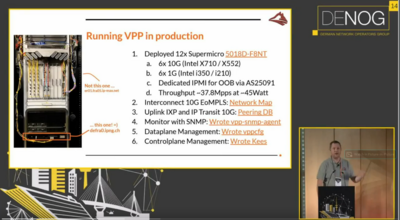VyOS DDoS mitigation
Real-time flow analytics on VyOS describes how to install real-time analytics based on sFlow and the sFlow-RT analytics engine. This article extends the example to show how to automatically mitigate DDoS attacks using flow analytics combined with BGP Remotely Triggered Black Hole (RTBH) / Flowspec.vyos@vyos:~$ add container image sflow/ddos-protectFirst, download the sflow/ddos-protect image.
vyos@vyos:~$ mkdir -m 777 /config/sflow-rtCreate a directory to store persistent container state.
set container network sflowrt prefix 192.168.1.0/24Define an internal network to connect to container. Currently VyOS BGP does not allow direct connections to local addresses (e.g. 127.0.0.1), so we need to put controller on its own network so the router can connect and receive DDoS mitigation BGP RTBH / Flowspec controls.
set container name sflow-rt image sflow/ddos-protect set container name sflow-rt host-name sflow-rt set container name sflow-rt arguments '-Dddos_protect.router=192.168.1.1 -Dddos_protect.enable.flowspec=yes' set container name sflow-rt environment RTMEM value 200M set container name sflow-rt memory 0 set container name sflow-rt volume store source /config/sflow-rt set container name sflow-rt volume store destination /sflow-rt/store set container name sflow-rt network sflowrt address 192.168.1.2
Configure a container to run the image. The Continue reading


 Defeating misinformation and misidrection in sales and vendor meetings
Defeating misinformation and misidrection in sales and vendor meetings

